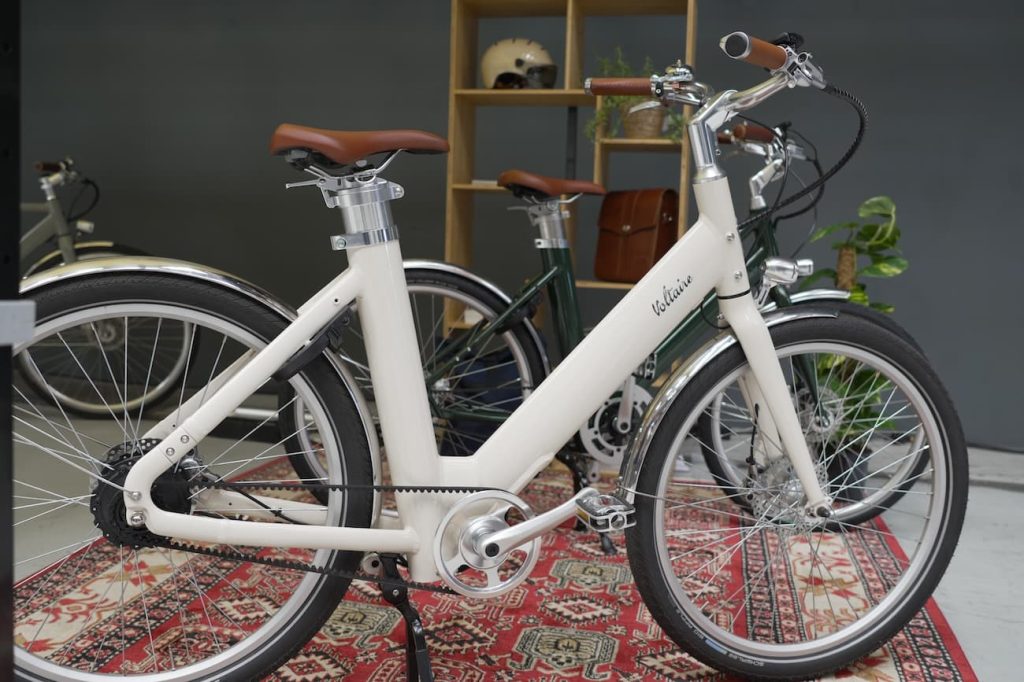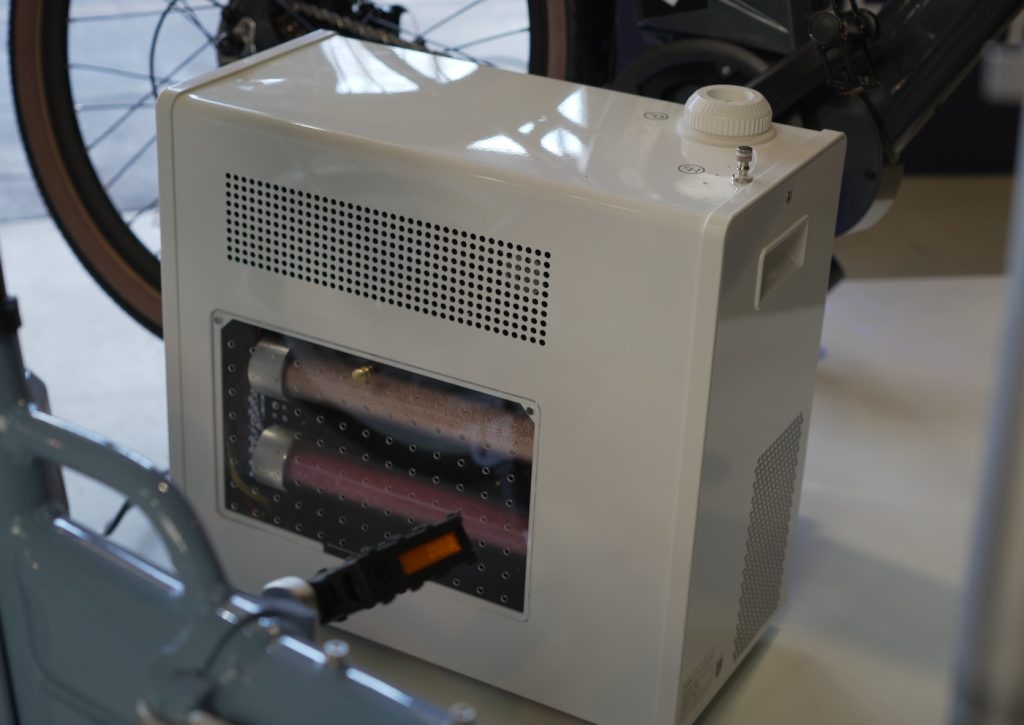I recently had the chance to attend Micromobility Europe 2024, the latest industry tradeshow promoting the proliferation of right-sized personal electric vehicles. For two days, the show took to Amsterdam to showcase many of the newest innovations and companies pushing the envelope on what micromobility vehicles can offer to urban residents.
Here is a smattering of many of the most interesting things I saw (and test rode) while exploring the show.
I’m going to run through these in no particular order, other than how they ended up being downloaded on my hard drive.
And to see even more, make sure you check out my video from the event, below. Then keep reading for all of the details!
Voltaire
This French electric bicycle company was new to me, but I instantly fell in love with their slick designs that invoke a classier, vintage vibe than we’re used to seeing in today’s ultramodern e-bike market.
With belt drives for simplicity and seat tube batteries to avoid a chunkier downtube, the bikes look like they’d make great commuter rides for anyone on the hunt for a more classic vibe.


Veloretti
The show’s European setting was a great chance to get introduced to e-bike companies that I don’t normally get to visit. Veloretti is based in Amsterdam, not far from the show’s venue, and so I got to see their more modern take on Dutch e-bikes firsthand.
I always love seeing a nice mix of old and new, so Veloretti’s Dutch-inspired designs were a refreshing sight. They seem to offer the kind of rider commuters are after, while still drawing on decades of the Netherlands’ rich history of cycling culture.



Cowboy Cross
Belgian e-bike company Cowboy had their newest model at the show, meaning I got to take the Cowboy Cross for a test ride through the surrounding Amsterdam neighborhoods.
With an inverted suspension fork, a suspension seat post, and slightly chunkier tires, the Cowboy Cross is definitely designed to handle rougher roads than a typical commuter bike.
This won’t take you offroading, but it will make those cobblestones and pot holes a lot less noticeable!


Bo
I always love seeing Bo’s electric scooters, as there’s just nothing else like it on the market. The scooter doesn’t fold, which is a rarity in the standing electric scooter world. But that means it’s much more rigid.
The scooter has a design all its own, and that seemed to win favor with the judges as Bo took the prize in this years Startup Awards at the show.
Now if I could just stop hearing the song “I’m Bo, yo!” in my head every time I write the scooter’s name, that’d be grreeeaaat.


Luna Systems
Out of left field was Luna Systems, which uses computer vision to make micromobility vehicles safer.
So far, they’ve mostly worked with commercial clients like scooter-sharing and bike-sharing companies, where their camera systems have helped improve the safety of those vehicles and keep riders accountable by tracking things like sidewalk riding.
But they also just unveiled their first consumer-facing product, the Luna Oculus, which is a camera system for cyclists that can warn you of upcoming close-passing cars that might risk your safety. If you opt-in, you can also share that data so other cyclists in your city can use the compounded data to learn which roads are the most dangerous for cyclists.
Luna is a startup that is funded by EIT Urban Mobility, an EU accelerator that looks for these types of innovative companies, as well as the next company on this list.




AD Knight
Continuing with the theme of using cameras and sensors to better protect vulnerable road users, AD Knight has a suite of software solutions that cities can use to understand and adapt to their growing micromobility ridership.
The company is currently starting a pilot with Peachtree City, Georgia, where intersections will be able to monitor and analyze the amount and type of micromobility users on the road. In the future, those intersections could potentially use AD Knight’s technology to adapt in real time, such as stretching a yellow light a few seconds longer to allow a slower-moving scooter rider to slip through before the signal changes for cross traffic.

Superfast Scooter
This one is a bit wild. These 40 mph (64 km/h) electric scooters are designed to offer motorcycle-like handling yet are intended to fold up so compact that they can fit in a golf bag for traveling.
They even use powertool batteries that are individually small enough to meet airline requirements for flights, yet add up to enough capacity and power for a fast electric scooter like this.
The design in still undergoing changes but the prototype showed what the company thinks is possible.


FLIT
This British folding e-bike makes me think that this is what Brompton should have built, instead of making something that looks like an e-bike conversion kit stuffed into a Brompton.
FLIT’s electric bike was purpose-built as an e-bike, meaning the electronics are integrated. However, it still folds up nearly as small as a Brompton, meaning it’s absolutely tiny.
You definitely need to watch it in action in my video at the top of this article.


Ebike OS
While we’re talking about Bromptons, I should also mention EbikeLabs, which showed off its control software in an electric Brompton at the show.
EbikeLabs doesn’t make any physical hardware, but instead offers impressive control software that can give e-bikes new features like hill hold and progressive regenerative breaking, among several other patents the company holds.
I tested out that regenerative braking, which is activated by pedaling backward like a coaster brake. It worked really well, which is saying something, considering a Brompton’s 16-inch wheel is the worst case scenario for powerful regenerative braking. Imagine that being applied to a larger commuter wheel, and the impact would be impressive.

Hydroride Europe AG
Ever tried a hydrogen-powered bicycle? Neither had I, at least not until I hopped on one of Hydroride Europe AG’s models at the show.
These hydrogen-powered bicycles have an on-board fuel cell that converts hydrogen from a small tank into electricity to power the rear hub motor.
To be honest, the ride didn’t feel that much different from most electric bicycles I’ve tested, which is sort of the point. The fuel may be different, but the ride is just as good.
Now whether or not hydrogen is a viable fuel for bicycles (or any other vehicle) is another question, and I’m not sure I see it taking off for consumers. But Hydroride is targeting commercial customers like bike-sharing companies who want to avoid depots full of charging batteries, so perhaps they’ll find some success on that front. For the rest of us, I don’t think we’ll be running hydrogen generators in our living rooms anytime soon.



Micromobility American show is coming soon!
It was great to see all of these companies and more at Micromobility Europe, and now it has me even more excited for what’s to come at Micromobility America this year.
The show will move to a new location this November, from San Francisco to Los Angeles this year, so make sure you stick around to hear what we find at the show this year. If you’re close to LA, you can still get early bird tickets, too.
FTC: We use income earning auto affiliate links. More.




